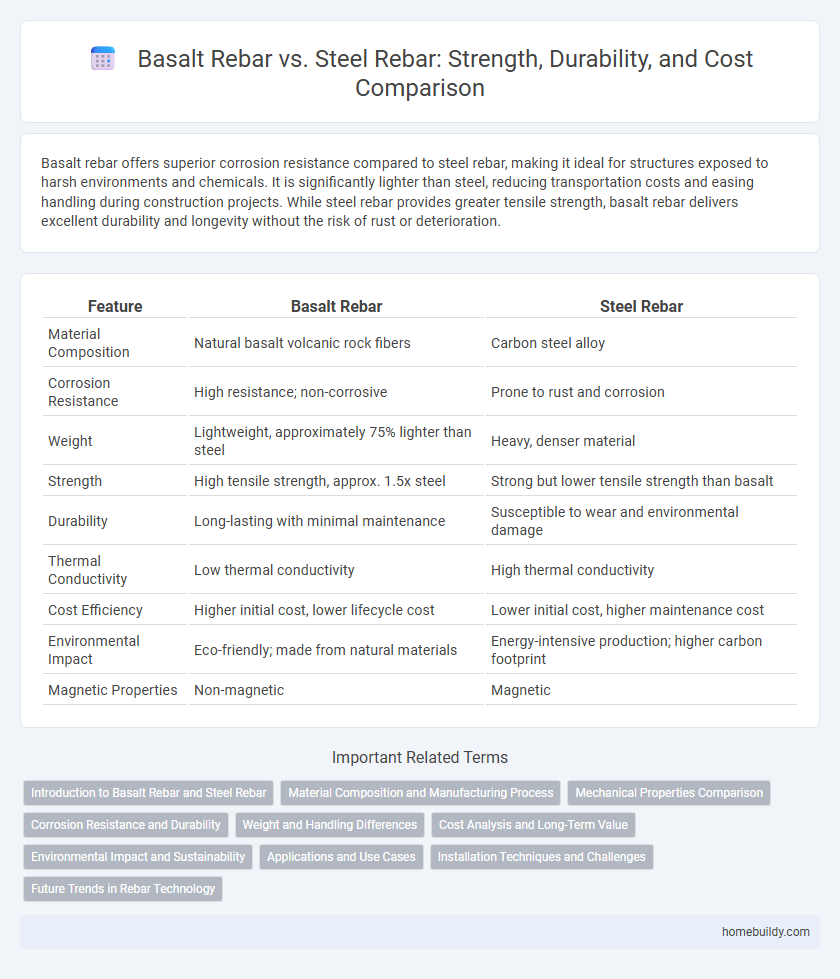Basalt rebar offers superior corrosion resistance compared to steel rebar, making it ideal for structures exposed to harsh environments and chemicals. It is significantly lighter than steel, reducing transportation costs and easing handling during construction projects. While steel rebar provides greater tensile strength, basalt rebar delivers excellent durability and longevity without the risk of rust or deterioration.
Table of Comparison
| Feature | Basalt Rebar | Steel Rebar |
|---|---|---|
| Material Composition | Natural basalt volcanic rock fibers | Carbon steel alloy |
| Corrosion Resistance | High resistance; non-corrosive | Prone to rust and corrosion |
| Weight | Lightweight, approximately 75% lighter than steel | Heavy, denser material |
| Strength | High tensile strength, approx. 1.5x steel | Strong but lower tensile strength than basalt |
| Durability | Long-lasting with minimal maintenance | Susceptible to wear and environmental damage |
| Thermal Conductivity | Low thermal conductivity | High thermal conductivity |
| Cost Efficiency | Higher initial cost, lower lifecycle cost | Lower initial cost, higher maintenance cost |
| Environmental Impact | Eco-friendly; made from natural materials | Energy-intensive production; higher carbon footprint |
| Magnetic Properties | Non-magnetic | Magnetic |
Introduction to Basalt Rebar and Steel Rebar
Basalt rebar, produced from volcanic basalt rock, offers exceptional corrosion resistance, high tensile strength, and lightweight properties compared to conventional steel rebar. Steel rebar, traditionally used in construction, provides robust structural support but is prone to rust and adds significant weight to concrete structures. The choice between basalt and steel rebar hinges on factors like durability, environmental conditions, and project load requirements.
Material Composition and Manufacturing Process
Basalt rebar is composed of natural volcanic rock fibers, produced through a process of melting basalt rock at high temperatures and extruding it into continuous fibers, resulting in a lightweight, corrosion-resistant reinforcement material. Steel rebar is manufactured by hot rolling steel billets into various shapes and sizes, offering high tensile strength but susceptibility to rust and corrosion in harsh environments. The manufacturing process of basalt rebar provides superior resistance to chemical erosion and electromagnetic interference compared to the traditional carbon steel rebar.
Mechanical Properties Comparison
Basalt rebar exhibits higher tensile strength, often ranging from 800 to 1500 MPa, compared to steel rebar's typical tensile strength of 400 to 550 MPa. Its superior corrosion resistance enhances durability, making it ideal for environments prone to chemical exposure. However, steel rebar offers greater ductility and toughness, which are crucial for structural flexibility and impact resistance.
Corrosion Resistance and Durability
Basalt rebar exhibits superior corrosion resistance compared to steel rebar, making it ideal for environments exposed to moisture, chemicals, and saltwater. This enhanced resistance significantly reduces deterioration and extends the lifespan of concrete structures. Consequently, basalt rebar offers greater durability and lower maintenance costs in infrastructure projects prone to corrosion-related damage.
Weight and Handling Differences
Basalt rebar is significantly lighter than steel rebar, weighing approximately one-quarter as much, which enhances ease of handling and reduces labor costs on construction sites. Its lower density allows for simpler transportation and faster installation, minimizing overall project timelines. The lightweight nature of basalt rebar also reduces worker fatigue and improves safety during handling compared to traditional steel rebar.
Cost Analysis and Long-Term Value
Basalt rebar generally offers a higher initial cost compared to traditional steel rebar but provides superior corrosion resistance and longevity, reducing maintenance and replacement expenses in the long term. Steel rebar is more cost-effective upfront but often incurs additional costs over time due to rust and structural degradation, especially in harsh environments. Considering total lifecycle costs, basalt rebar presents a better long-term investment for infrastructure projects susceptible to corrosion and environmental wear.
Environmental Impact and Sustainability
Basalt rebar offers significant environmental benefits over steel rebar due to its lower carbon footprint and energy consumption during production. It is made from naturally abundant volcanic basalt rock, which requires less energy to extract and process, reducing greenhouse gas emissions. Steel rebar production involves intensive mining and smelting processes that contribute to higher carbon emissions and resource depletion, making basalt rebar a more sustainable choice for eco-friendly construction projects.
Applications and Use Cases
Basalt rebar is increasingly utilized in infrastructure projects requiring corrosion resistance and non-magnetic properties, such as bridges, marine structures, and electrical substations. Steel rebar remains preferred for heavy-load applications like skyscrapers and highways due to its superior tensile strength and ductility. The choice between basalt and steel rebar hinges on environmental conditions and structural demands, with basalt favored in chemically aggressive environments and steel in high-stress scenarios.
Installation Techniques and Challenges
Basalt rebar offers simpler installation due to its lightweight nature and corrosion resistance, reducing the need for heavy equipment and protective coatings compared to steel rebar. Steel rebar requires careful handling to avoid rust and often involves more labor-intensive cutting and bending processes. Challenges with basalt rebar include limited availability of specialized tools and the need for training installers in new techniques, whereas steel rebar benefits from widespread familiarity and established procedures.
Future Trends in Rebar Technology
Basalt rebar is gaining traction as a sustainable alternative to traditional steel rebar due to its high corrosion resistance and lower carbon footprint, positioning it as a key material in future infrastructure projects. Innovations in composite rebar technology are enhancing the durability and tensile strength of basalt rebar, making it a competitive option for seismic-resistant construction. As global demand shifts towards eco-friendly materials, basalt rebar's lightweight properties and ease of installation are expected to drive widespread adoption in advanced civil engineering applications.
Basalt Rebar vs Steel Rebar Infographic

 homebuildy.com
homebuildy.com